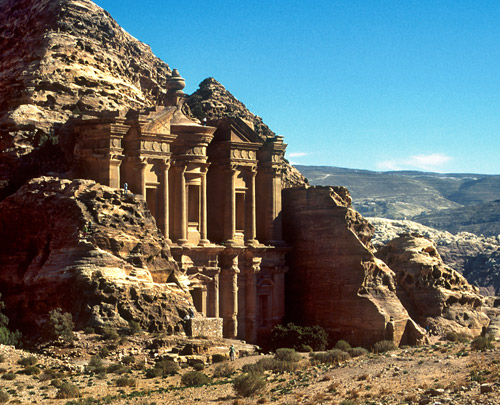苍兰博客
靠你有力量,心中想往锡安大道的,这人便为有福! 他们经过流泪谷,叫这谷变为泉源 之地;并有秋雨之福盖满了全谷 。
Jordan, Petra
Article and pictures from
http://www.atlastours.net/jordan/petra.html
佩特拉是约旦南部的一座历史古城,距首都安曼约260公里。隐没于死海和阿克巴湾(今天的约旦国境内)之间的山峡中。它是约旦南部沙漠中的神秘古城之一,也是约旦最负盛名的古迹区之一。佩特拉位于干燥的海拔1000米的高山上,几乎是全在岩石上雕刻而成。
佩特拉为公元前4~公元2世纪纳巴泰王国首都。位于约旦安曼西南 250公里处。希腊文意为“岩石”。《旧约全书》称“塞拉”(Sela)。公元前 1 世纪, 在国王阿雷特斯三世统治时极其繁荣,疆土曾扩大到大马士革。公元 106年被罗马帝国皇帝图拉真军队攻陷,沦为罗马帝国的一个行省。曾作为商路要道盛极一时。3世纪起,因红海海上贸易兴起代替了陆上商路,佩特拉开始衰落, 7世纪被阿拉伯军队征服时,已是一座废弃的空城。1812年为瑞士人J.L.伯尔克哈特重新发现。

佩特拉遗迹有一条长约1.5公里的狭窄峡谷通道。峡谷最宽处约 7米,最窄处仅 2米左右,两侧雕凿有洞窟、岩墓等。峡谷尽头豁然开朗,耸立着一座高约40米、宽约30米的依山雕凿的哈兹纳赫殿堂(意为金库)造型雄伟,有 6根罗马式门柱,分上、下两层,直至洞顶。横梁和门檐雕有精细图案。穿过哈兹纳赫殿堂前面的小谷,有古罗马剧场遗迹。剧场后面有一片开阔地,城市依四周山坡建筑而成,有寺院、宫殿、浴室和住宅等。还有从岩石中开凿出来的水渠。在东北部的山岩上开凿有石窟,其中有一座气势雄伟的三层巨窟,正面为罗马宫殿建筑风格,是历代国王的陵墓。现设有佩特拉石窟博物馆。联合国教科文组织已将该处列为世界文化遗产之一。
Petra is the treasure of ancient world, hidden behind an almost impenetrable barrier of rugged mountains, boasting incomparable scenes that make it the most majestic and imposing ancient site still-standing nowadays.. It has been said "perhaps there is nothing in the world that resembles it", actually, for sure, there is nothing in the world that resembles it. The rock-carved rose-red city of Petra is full of mysterious charm, it was "designed to strike wonder into all who entered it".
Petra is considered the most famous and gorgeous site in Jordan located about 262 km south of Amman and 133 km north of Aqaba. It is the legacy of the Nabataeans, an industrious Arab people who settled in southern Jordan more than 2000 years ago. Admired then for its refined culture, massive architecture and ingenious complex of dams and water channels, Petra is now a UNESCO world heritage site and one of The New 7 Wonders of the World that enchants visitors from all corners of the globe.
The approach through a kilometer long, cool, and gloom chasm (or Siq) a long narrow gorge whose steeply rising sides all but obliterate the sun, provides a dramatic contrast with the magic to come. Suddenly the gorge opens into a natural square dominated by Petra's most famous monument, The Treasury (El-Khazneh), whose intricately carved facade glows in the dazzling sun.
More facades beckon the visitor on until the ancient city gradually unfolds, one monument leading to the next for kilometer after kilometer. The sheer size of the city and the quality of beautifully carved facades is staggering and leads one to reflect on the creativity and industry of the Nabataeans who made Petra their capital.
Petra is always breathtaking, and never to be forgotten. It flourished for over 400 years around the time of Rome and Christ (pbuh), until it was occupied by the Roman legions of the Emperor Trajan in 106 AD.
The Petra basin boasts over 800 individual monuments, including buildings, tombs, baths, funerary halls, temples, arched gateways, and colonnaded streets, that were mostly carved from the kaleidoscopic sandstone by the technical and artistic genius of its inhabitants.
Petra sights are at their best in early morning and late afternoon, when the sun warms the multicolored stones, you can view the majesty of Petra as it was seen first when discovered in 1812 after being lost by the 16th century for almost 300 years!




